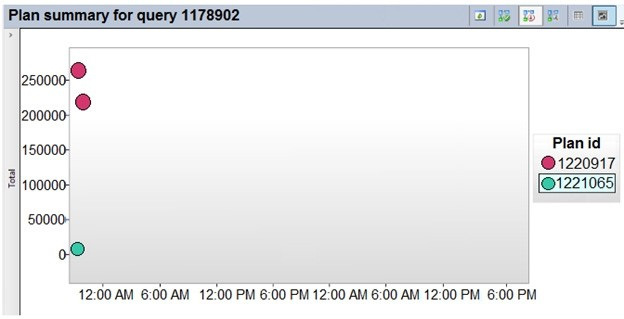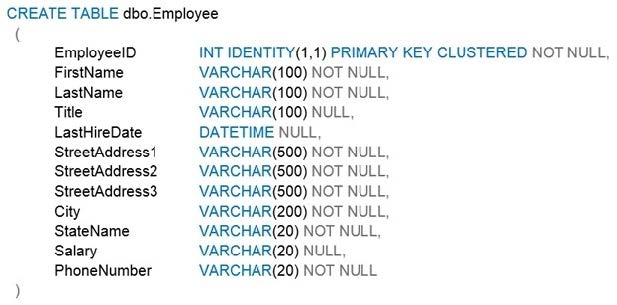Exam Details
Exam Code
:DP-300Exam Name
:Administering Relational Databases on Microsoft AzureCertification
:Microsoft CertificationsVendor
:MicrosoftTotal Questions
:368 Q&AsLast Updated
:Jun 30, 2025
Microsoft Microsoft Certifications DP-300 Questions & Answers
-
Question 151:
You have an Azure SQL database.
Users report that the executions of a stored procedure are slower than usual. You suspect that a regressed query is causing the performance issue.
You need to view the query execution plan to verify whether a regressed query is causing the issue. The solution must minimize effort.
What should you use?
A. Performance Recommendations in the Azure portal
B. Extended Events in Microsoft SQL Server Management Studio (SSMS)
C. Query Store in Microsoft SQL Server Management Studio (SSMS)
D. Query Performance Insight in the Azure portal
-
Question 152:
You have SQL Server on an Azure virtual machine that contains a database named DB1.
You view a plan summary that shows the duration in milliseconds of each execution of query 1178902 as shown in the following exhibit:

What should you do to ensure that the query uses the execution plan which executes in the least amount of time?
A. Force the query execution plan for plan 1221065.
B. Run the DBCC FREEPROCCACHE command.
C. Force the query execution plan for plan 1220917.
D. Disable parameter sniffing.
-
Question 153:
You have an Azure SQL database named DB1. You run a query while connected to DB1.
You review the actual execution plan for the query, and you add an index to a table referenced by the query.
You need to compare the previous actual execution plan for the query to the Live Query Statistics.
What should you do first in Microsoft SQL Server Management Studio (SSMS)?
A. For DB1, set QUERY_CAPTURE_MODE of Query Store to All.
B. Run the SET SHOWPLAN_ALL Transact-SQL statement.
C. Save the actual execution plan.
D. Enable Query Store for DB1.
-
Question 154:
You have an Azure SQL database.
You discover that the plan cache is full of compiled plans that were used only once.
You run the select * from sys.database_scoped_configurations Transact-SQL command and receive the results shown in the following table.

You need relieve the memory pressure. What should you configure?
A. LEGACY_CARDINALITY_ESTIMATION
B. QUERY_OPTIMIZER_HOTFIXES
C. OPTIMIZE_FOR_AD_HOC_WORKLOADS
D. ACCELERATED_PLAN_FORCING
-
Question 155:
You deploy a database to an Azure SQL Database managed instance.
You need to prevent read queries from blocking queries that are trying to write to the database.
Which database option should set?
A. PARAMETERIZATION to FORCED
B. PARAMETERIZATION to SIMPLE
C. Delayed Durability to Forced
D. READ_COMMITTED_SNAPSHOT to ON
-
Question 156:
A data engineer creates a table to store employee information for a new application. All employee names are in the US English alphabet. All addresses are locations in the United States. The data engineer uses the following statement to create the table.

You need to recommend changes to the data types to reduce storage and improve performance. Which two actions should you recommend? Each correct answer presents part of the solution. NOTE: Each correct selection is worth one point.
A. Change Salary to the money data type.
B. Change PhoneNumber to the float data type.
C. Change LastHireDate to the datetime2(7) data type.
D. Change PhoneNumber to the bigint data type.
E. Change LastHireDate to the date data type.
-
Question 157:
You have an Azure SQL database.
You identify a long running query.
You need to identify which operation in the query is causing the performance issue.
What should you use to display the query execution plan in Microsoft SQL Server Management Studio (SSMS)?
A. Live Query Statistics
B. an estimated execution plan
C. an actual execution plan
D. Client Statistics
-
Question 158:
You have a version-8.0 Azure Database for MySQL database.
You need to identify which database queries consume the most resources.
Which tool should you use?
A. Query Store
B. Metrics
C. Query Performance Insight
D. Alerts
-
Question 159:
You have SQL Server on an Azure virtual machine that contains a database named DB1.
You have an application that queries DB1 to generate a sales report.
You need to see the parameter values from the last time the query was executed.
Which two actions should you perform? Each correct answer presents part of the solution.
NOTE: Each correct selection is worth one point.
A. Enable Last_Query_Plan_Stats in the master database
B. Enable Lightweight_Query_Profiling in DB1
C. Enable Last_Query_Plan_Stats in DB1
D. Enable Lightweight_Query_Profiling in the master database
E. Enable PARAMETER_SNIFFING in DB1
-
Question 160:
Note: This question is part of a series of questions that present the same scenario. Each question in the series contains a unique solution that might meet the stated goals. Some question sets might have more than one correct solution, while
others might not have a correct solution.
After you answer a question in this section, you will NOT be able to return to it. As a result, these questions will not appear in the review screen.
You have an Azure Data Lake Storage account that contains a staging zone.
You need to design a daily process to ingest incremental data from the staging zone, transform the data by executing an R script, and then insert the transformed data into a data warehouse in Azure Synapse Analytics.
Solution: You schedule an Azure Databricks job that executes an R notebook, and then inserts the data into the data warehouse.
Does this meet the goal?
A. Yes
B. No
Related Exams:
62-193
Technology Literacy for Educators70-243
Administering and Deploying System Center 2012 Configuration Manager70-355
Universal Windows Platform – App Data, Services, and Coding Patterns77-420
Excel 201377-427
Excel 2013 Expert Part One77-725
Word 2016 Core Document Creation, Collaboration and Communication77-726
Word 2016 Expert Creating Documents for Effective Communication77-727
Excel 2016 Core Data Analysis, Manipulation, and Presentation77-728
Excel 2016 Expert: Interpreting Data for Insights77-731
Outlook 2016 Core Communication, Collaboration and Email Skills
Tips on How to Prepare for the Exams
Nowadays, the certification exams become more and more important and required by more and more enterprises when applying for a job. But how to prepare for the exam effectively? How to prepare for the exam in a short time with less efforts? How to get a ideal result and how to find the most reliable resources? Here on Vcedump.com, you will find all the answers. Vcedump.com provide not only Microsoft exam questions, answers and explanations but also complete assistance on your exam preparation and certification application. If you are confused on your DP-300 exam preparations and Microsoft certification application, do not hesitate to visit our Vcedump.com to find your solutions here.